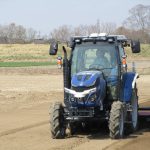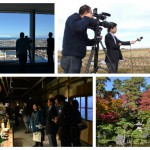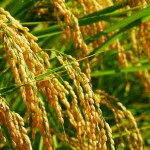Date : July 8, 2019
Notice: Tokyo Nerima Press Tour—A Town with Living Agriculture
post date : 2019.06.21
Date: Monday, July 8, 2019
Topic: Urban agriculture in Nerima providing a fulfilling lifestyle
In recent years, the role and appeal of having farmland in cities has been reconsidered in nations around the world, and there has been a new movement of “urban agriculture.” In New York, farms in the city using roof tops and floors inside of buildings have become a trend. In London, 2700 community gardens were established on the occasion of the 2012 London Olympic and Paralympic Games, and in Seoul, the city announced its Urban Agriculture 2.0 Vision in 2015.
The Basic Law on the Promotion of Urban Agriculture was enacted in 2015 in Japan, establishing that urban farmland, which had been thought of as “land which should be turned into residential land,” was instead “farmland which should exist in cities”, and urban farmland began to be used as a local resource. Community gardens are growing popular in municipalities throughout Japan. People with no connection to agriculture are enjoying growing vegetables on plots of land they borrow, and some even decide to make a living in agriculture. Urban agriculture is changing the perception of people living in cities.
Nerima, located at the northwest edge of Tokyo’s 23 wards, has farmland dotted throughout its quiet residential areas where 730,000 people live. With some farms established in the Edo period (1603–1868) still operating today, there are few other places like it in the world. Approximately 40% of the farmland in the 23 wards, around 200 hectares, is located in Nerima. A variety of fruits and vegetables are grown there, and it is the largest producer of cabbage in Tokyo. It is also home to the famous “Edo vegetable” the Nerima daikon, and has the highest number of agritourism sites in Tokyo, such as for blueberry picking. Since producers are close to consumers, it is possible to taste fresh produce picked that day. Nerima is also the birthplace of farms where visitors can experience a taste of what it is like to work on a farm. Acting as a place where everyone from children to seniors can learn about agriculture and food, and where Nerima residents and farmers can interact, they help bring more variety to city life.
This tour will visit Nerima, leading the urban agriculture movement in Japan as a city in harmony with farmland. The tour will learn about the new relationship between agriculture and urban life created by urban agriculture, visiting a farm whose chrysanthemums decorated the 1964 Tokyo Olympics but is now a blueberry picking farm, a farm that has continued since the Edo period (1603–1868) growing a variety of crops despite being surrounded by homes, a bistro where abundant fresh Nerima vegetables can be eaten, the only Tokyo miso maker continuing to produce traditional handmade miso and a farm encouraging interaction between citizens such as with farming experiences for children.
****************************************
1. Asami Farm, a “Casual Farm” Orchard
-Switched from a farm that grew chrysanthemums dedicated to the 1964 Tokyo Olympics to a blueberry picking farm with over 300 daily visitors
Nerima is home to a number of “casual farms” (pun: 果樹ある, kajuaru=has fruit trees) which residents can visit throughout the year to pick fruits such as blueberries, grapes, mikan (satsuma mandarin), kiwis, persimmons and strawberries. Nerima has the most agritourism farms of any ward in Tokyo, with 31 blueberry picking farms. Blueberry picking is a fun and simple agricultural experience that both children and adults can enjoy, and Asami Farm, run by Mr. Kiyoshi Asami, has over 300 visitors daily during the season. He began growing blueberries at the age of 70 because they do not require too much care, but he previously grew flowers such as pansies, petunias, and chrysanthemums.
Mr. Asami grew chrysanthemums, a symbol of Japan, which were used at the opening ceremony of the 1964 Tokyo Olympics. Chrysanthemums which he had grown himself were used to line both sides of the stairs leading up to the Olympic cauldron, and the final Olympic torch runner was shown live on television running along this fragrant chrysanthemum path.
Chrysanthemums bloom at different times depending on the weather and temperature of that year, making them a difficult plant to cultivate. In order to grow the best flowers possible for the opening ceremony, Mr. Asami carried out careful calculations and grew 9,000 flowers in order to ensure he could deliver 1,500. Reflecting on that time, he commented, “That year was a constant battle with the chrysanthemums. Although it was the athletes who expended the most effort at the Olympics, I was also able to provide the best flowers possible thanks to everyone’s support.”
At Asami Farm, the tour will see blueberries being grown in a residential area, learn about the convenient berry picking that anyone can enjoy, and hear from Mr. Asami about his experiences growing chrysanthemums for the 1964 Tokyo Olympics.
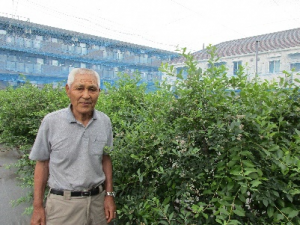


[Photos (center and right) provided by Nerima Ward]
2. Nishigai Farm
-A farm continuing since the Edo period proves the appeal and meaning of carrying out urban agriculture
Mr. Nobuo Nishigai left the company he had been working at about 10 years ago, and started agriculture by taking over his father-in-law’s farm, which first started in the Edo period. He grows a small amount of a variety of different seasonal crops, including tomato, cucumber, onion, long green onion, taro, kabocha, cabbage, broad bean, edamame, okra, garlic, and watermelon. With a motto of “growing vegetables others don’t,” he also grows a variety of rare and colorful vegetables, such as white corn, yellow zucchini, purple napa cabbage, and orange cauliflower. As a contracted farm for the local Nerima bistro Boncourage, the variety of crops he grew increased significantly after he began to collaborate with the bistro. Mr. Nishigai is also involved in new initiatives such as developing new sales routes to restaurants and holding farmers’ markets with younger farmers.
Urban agriculture has the benefit of there being very little distance between farmers and residents. The children at the local preschools and elementary schools see the vegetables growing and changing color little by little as part of their daily lives while they grow up. This also causes some issues, as since the fields are right by homes and school routes, care must be taken to avoid using loud machines in the early morning, such as for cultivation or disinfecting vegetables.
The tour will learn about the production of diverse crops in small amounts at Nishigai Farm. Mr. Nishigai will talk about the appeal and meaning behind doing agriculture in the city as a younger farmer, and his initiatives for younger farmers.



3. Bistro Boncourage
-Working with farmers to serve fresh Nerima vegetables
Boncourage is a bistro based on the concept of having local customers enjoy vegetables made in Nerima. Mr. Yoshio Okoshi, the manager and a vegetable sommelier, has experience in a variety of restaurants including at Hotel Seiyo Ginza, and joined in planning the bistro in 2009, working as the manager since 2011.
Mr. Okoshi became entranced by the taste of fresh Nerima vegetables, which have the natural sweetness vegetables should, and went around to farms in Nerima seeing if they could fulfill the conditions necessary for French cuisine, being able to provide a steady supply of standard vegetables and also produce rare and colorful vegetables. This is when he met Mr. Nishigai of Nishigai Farm. He moved nearby to Nishigai Farm to help with growing the vegetables, and now serves 80 different Nerima vegetables at his bistro. The vegetables are so fresh, even the eggplant, zucchini, and corn can be eaten raw.
At Boncourage, the tour will eat lunch made with fresh Nerima ingredients, including vegetables grown by Mr. Nishigai and handmade miso made at the miso maker that is the next stop on the tour. The tour will hear about the collaboration between Mr. Nishigai and Mr. Okoshi, who commented, “It is because I understand the struggles of farmers that I want consumers to be able to taste how good Nerima vegetables are.”
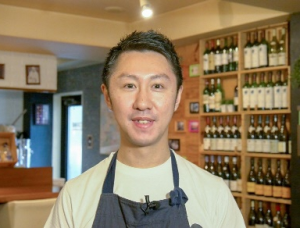
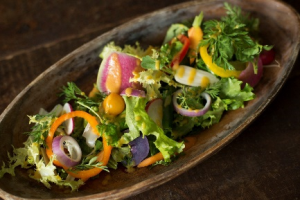
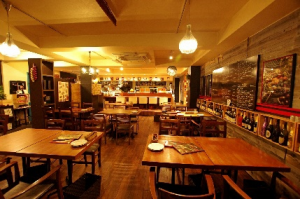
[Photos provided by Boncourage]
-Tokyo’s only miso maker, making traditional handmade miso good for the body and soul
Kojiya Saburoemon is the only miso maker in Tokyo, and makes handmade miso. The company was founded in Ibaraki prefecture in the Meiji period (1868-1912), and opened their production location in Nerima in 1939. The current owner, Mr. Masahiro Tsujita, is the seventh-generation owner. They use 100% Japanese-grown rice for the koji, which is critical to the quality of miso, and carefully selected Japanese-grown soy, with no additives. In the belief that texture and aroma is important when making miso, they avoid using machines as much as possible and use handmade processes to protect the traditional flavor.
When preparing to make miso, the yeast that has grown to live there over the years is involved and gives the miso its unique taste, so large wooden barrels which have been used for years are still used. There are some barrels at Kojiya Saburoemon that have been used for over 100 years, and no plastic containers are used. When aging and fermenting the miso, the temperature and weather have a significant impact, and so the miso that is made is unique each time. In addition to miso made using white rice, brown rice, barley, and wheat, other products such as Yuki no Hana koji, which was made over generations of research, are sold online. They are also working on making miso using soy grown in Nerima.
The tour will visit Kojiya Saburoemon, and hear about Mr. Tsujita’s passion and philosophy on making traditional miso.
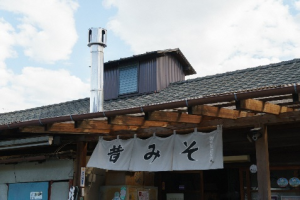
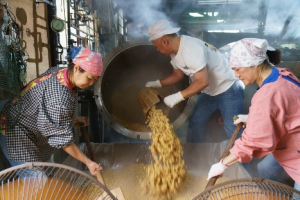
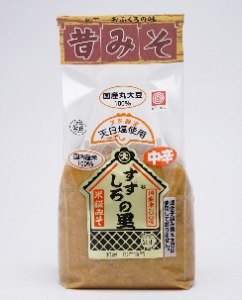
[Photos provided by Kojiya Saburoemon]
-Popular coin locker vegetable stand with Nerima vegetables
Mr. Tadao Yoshida runs Suzushiro Farm along with his son. They set up a vegetable stand with coin-operated lockers right by their field, and place vegetables harvested that day in the lockers each morning. Depending on the season, they sell crops such as eggplant, tomato, cucumber, onion, and potato, and since fresh vegetables can be easily bought, it is popular with the locals and often sells out before noon. They were also the third farm in Nerima to start providing agricultural experiences, and currently loan out all 120 plots of their land to teach users how to farm.
The agricultural experience farms that were created in Nerima in 1996 are farms where the owner receives assistance and subsidies from the local government, and provides users with careful instruction as the users experience everything from seeding and planting to harvesting. Nerima has the most land used for agricultural experience farms of anywhere in Japan. The program is popular, as it enables people to enjoy farm life while living and working in the city, as well as encouraging interaction between farmers and residents, and there are now agricultural experience farms in over 140 locations throughout Japan.
The tour will see the coin locker vegetable stand where fresh vegetables can be purchased in a residential area, and speak with Mr. Yoshida.
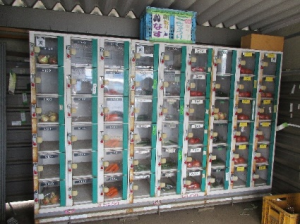
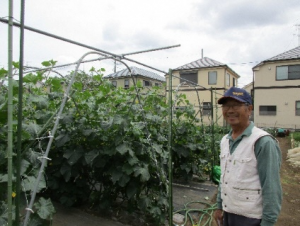
6. Eco Farm Yoshida
-Farmland near a school as a classroom for children: Contributing to the community with farmland in a city
Mr. Shigeo Yoshida, owner of Eco Farm Yoshida, uses fertilizer made from manure he receives from the equestrian clubs of universities in Tokyo such as Keio and Gakushuin, mixed with vegetable peels and cores and rice bran. He grows corn, edamame, potato, sweet potato, onion, daikon, and cabbage. His vegetables, with which he uses as little chemical fertilizer as possible, are popular for being very sweet.
Every morning, the vegetables which he has harvested are sent to up to eight schools in Nerima and throughout Tokyo, where they are served to the children at lunch. Mr. Yoshida said that it is encouraging when schoolchildren on their way home tell him, “Lunch tasted good today!” He also participates in some elementary school classes, providing the schoolchildren with opportunities to visit Eco Farm Yoshida and learn about tilling the soil and harvesting vegetables. This farmland inside the city fulfills a major role in the food education of the children.
The tour will visit Eco Farm Yoshida and learn about Mr. Yoshida’s contributions to the local community, including using the farm to teach children.

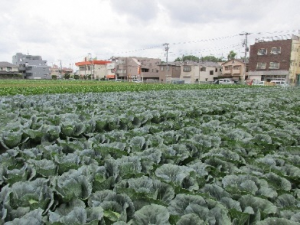
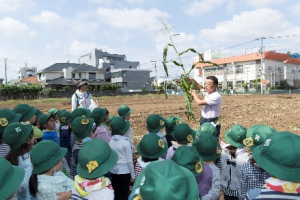
[Photo (right) provided by Nerima Ward]
7. Interview with Nerima Mayor Akio Maekawa
-From Nerima to the world: Preparing for the Urban Agriculture World Summit in November 2019
From November 29 to December 1, 2019, the Urban Agriculture World Summit will be held in Nerima. With the role and value of agricultural land in major cities being reconsidered throughout the world, this event will invite government staff and researchers from Jakarta, London, New York, Seoul, and Toronto. There will be symposiums, working groups, and demonstrations of agricultural experiences, with the goal of sharing the significance and appeal of urban agriculture and communicating it to the world. Mr. Maekawa commented, “I would like to show the world how active agriculture is being carried out in Nerima as part of residents’ lives, despite being located in Tokyo, one of the biggest cities in the world.”
Mayor Akio Maekawa will speak about urban agriculture in Nerima and his thoughts on the Urban Agriculture World Summit.
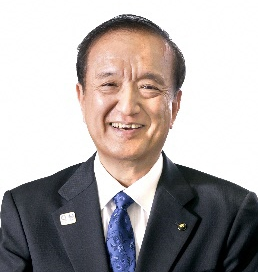
[Photo provided by Nerima Ward]
****************************************
[Tour Details]
1. Schedule
*The schedule is not yet finalized, and may change without notice.
<July 8 (Mon.)>
8:00 Meet at Kotake-mukaihara Station (Tokyo Metro Yurakucho Line/Fukutoshin Line, Seibu Yurakucho Line)
8:30-9:00 Briefing about urban agriculture in Nerima
9:00-10:00 Asami Farm (blueberry picking farm)
10:15-11:30 Nishigai Farm (a farm that has continued since the Edo period (1603–1868))
11:45-13:00 Lunch at Boncourage (a bistro where fresh Nerima vegetables can be eaten)
13:15-14:30 Kojiya Saburoemon (the only Tokyo miso maker)
14:45-16:00 Suzushiro Farm (coin locker vegetable stand), Eco Farm Yoshida (using the farm to contribute to the community)
16:15-17:00 Interview with Nerima Mayor Akio Maekawa
17:30 Arrive at Kotake-mukaihara Station
2. Qualification: Bearer of Gaimusho Press Registration Card
3. Cost: 2,000 Yen per person including transportation in Nerima and lunch.
*Information on payment and cancellation fee will be provided to participants.
*You are responsible for round-trip fare to Kotake-mukaihara Station.
4. Participants: Limited to 10 applicants.
(Only one reporter or one photographer from each company, but two participants from each TV team will be acceptable.)
*If the number of applicants exceeds 10, an upper limit may be set on the number of participants from each country/region.
5. FPCJ Contact: Hamada (Ms.), Nakano (Ms.), Koizumi (Ms.)
(Tel: 03-3501-3405 | E-mail: ma@fpcjpn.or.jp)
6. Remarks:
(1) This tour is organized by Nerima city office and planned and operated by the FPCJ.
(2) The schedule is subject to change without notice.
(3) This tour will require participants to bear part of the cost, but is not a profit-making venture.
(4) Neither the organizer nor FPCJ will be liable for any inconvenience, trouble or accidents that might occur during the tour.
(5) There may be some restrictions on photographing and filming at the tour sites. Please follow the instructions of the staff in charge.





